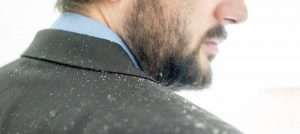
Dandruff isn’t quite the most glamorous of all hair topics, but hey, if you have hair, it’s likely you’ve had dandruff at some point in your life. Unfortunately, dandruff can be more than just white flakes on your scalp. Sometimes it can lead to itchy, red patches that scab over and even bleed. So, if you’re attempting to figure out how to remove dandruff, look no further. We’ve consulted with the dermatologist Dr. Waleed Alsalhi to help narrow down the best ways to treat this pesky problem.
What is dandruff a sign of?
Dandruff basically occurs when small pieces of dry skin fall off the scalp. You may see these flakes in your hair or on your shoulders. Although dandruff is a common problem, it’s not as simple as it sounds. Dandruff is actually quite difficult to define because it gets confused with seborrheic dermatitis (a chronic form of eczema) and other skin conditions that cause scalp flaking.
According to Dr. Waleed Alsalhi, dandruff is most often a sign of increased sebum production and yeast overgrowth and can be a sign of scalp inflammation.
The severity of dandruff can vary from case to case. Some cases are less aggressive and easy to treat, while others may require medication. Dr. Waleed Alsalhi states that dandruff can be diagnosed in three ways:
- Clinically
- Dermoscopy/Trichoscopy
- Microscopy
Are there any risk factors associated with dandruff?
Although anyone can be prone to dandruff, it is more common in men than in women. According to Dr. Waleed Alsalhi, dandruff usually appears after puberty, when androgen levels increase, and peaks in the 20s. Having an oily scalp and hair can also increase the risk of developing the condition.
Which scalp conditions can cause dandruff?
Dr. Waleed Alsalhi points out that all inflammatory and infectious diseases can produce dandruff on the scalp, such as scalp psoriasis, scalp seborrheic dermatitis, lichen planus pilaris, discoidal lupus of the scalp, and tinea capitis (fungal infection).
Keep reading to find out how to remove dandruff from your hair once and for all.
How to remove dandruff from hair?
No matter the season, a flaky scalp can be an embarrassing condition. Below are tips and suggestions to solve your scalp problem.
Dandruff treatment options include:
- Change your diet
A poor diet can cause dandruff. Foods high in carbohydrates can cause a build-up of glycogen in the skin, which yeast feeds on. Sugary foods and dairy products stimulate the sebaceous glands, which produce more sebum on the skin. Unfortunately, if you are prone to dandruff, you may need to avoid carbohydrates and sugars.
- Use a special shampoo
The itching and flaking of dandruff can nearly always be controlled. Try a medicated anti-dandruff shampoo. You may need to try more than one shampoo to find the right hair care regimen for you.
Dandruff shampoos are classified by the medication they contain:
- Zinc pyrithione shampoos. They contain an antibacterial and antifungal agent, zinc pyrithione.
- Tar-based shampoos. Coal tar slows the rate at which skin cells on your scalp die and flake off. If you have light hair, this type of shampoo can cause discoloration. It can also leave your scalp more sensitive to sunlight.
- Shampoos containing salicylic acid. These products help remove scale.
- Selenium sulfide shampoos. These products contain an antifungal agent. Use them as directed and rinse well after shampooing, as they can discolor hair and scalp.
- Ketoconazole shampoos. These shampoos are designed to kill the dandruff-causing fungi that live on your scalp.
If one type of shampoo works for a while and then seems to lose its effectiveness, try switching between two types of dandruff shampoos. Some products should be left on for a few minutes, while others should be rinsed off quickly.
According to Dr. Waleed Alsalhi, the hair washing routine varies from person to person depending on their scalp/hair oiliness and hair products. However, keep in mind that in order to treat dandruff, one should wash the scalp with an anti-dandruff shampoo at least 2-3 times a week. Always check the product label to make sure of the frequency.
If you have been using a medicated shampoo regularly for several weeks and still have dandruff, talk to your doctor. Dr. Waleed Alsalhi notes that oral medications and/or compounded solutions will be added in resistant cases.
Fortunately, treating dandruff can often be as simple as choosing the right shampoo. We’ve got 4 dermatologist-approved shampoos to help you say bye-bye to flakes for good.
For oily dandruff:
Squanorm Anti-Dandruff Treatment Shampoo – Oily Dandruff
For dry dandruff:
Squanorm Anti-Dandruff Treatment Shampoo – Dry Dandruff:
For dandruff caused by seborrheic dermatitis:
Kelual DS Anti-Dandruff Treatment Shampoo
For dandruff caused by psoriasis:
Kertyol P.S.O Keratoreducing Shampoo
- Try treatment creams
For dandruff caused by skin conditions such as psoriasis and eczema, it’s important to use the creams mentioned below to remove flakes and soothe itching and redness.
For dandruff caused by seborrheic dermatitis:
Kelual DS Squamo-reducing Soothing Cream
For dandruff caused by psoriasis:
Kertyol P.S.O Concentrate
- Get a little sun
Sunlight can be beneficial in the fight against dandruff. It helps suppress the fungus that causes dandruff. Just make sure to protect your skin, including exposed scalp, by using a broad-spectrum sunscreen with an SPF of 30 or higher.
- Learn to manage stress
Stress affects your overall health and makes you vulnerable to several conditions and diseases. It can even contribute to triggering dandruff or worsening existing symptoms.
- Don’t scratch
While you’re dealing with dandruff, try to resist the urge to scratch your scalp. Itching is initially caused by irritation from dandruff, but scratching increases the irritation and leads to a vicious cycle.
Final thoughts
If you suffer from a flaky, itchy scalp, it’s essential to find the best dandruff treatment for your hair type that fits perfectly into your hair care routine. Since dandruff can be a bit unsightly and cause irritation and itching, it’s important to use the right shampoos and treatments to soothe your scalp and treat the root cause.
Luckily, Ducray, a well-known brand, has developed the above products to help remedy itchy scalp and treat dandruff. These anti-dandruff products help make this annoying scalp problem a distant memory. Flake-free is the way to be!















